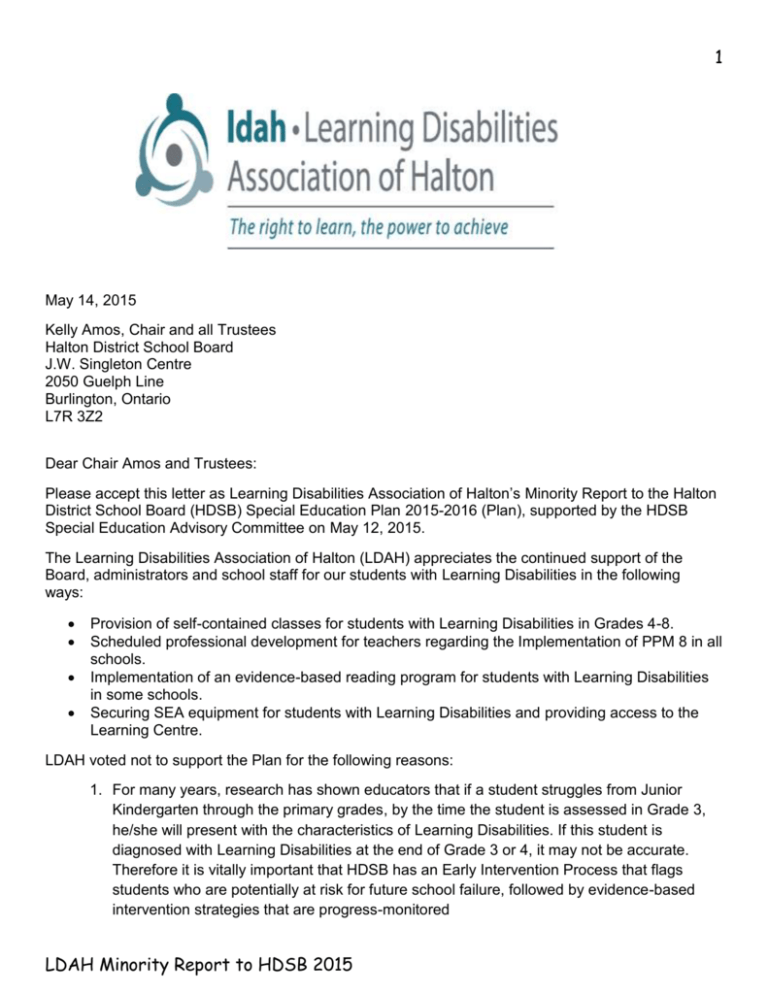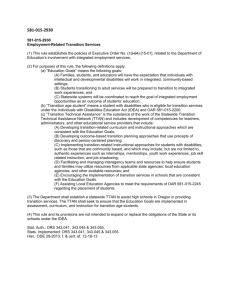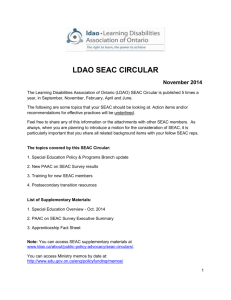LDAH Minority report May 14, 2015
advertisement

1 May 14, 2015 Kelly Amos, Chair and all Trustees Halton District School Board J.W. Singleton Centre 2050 Guelph Line Burlington, Ontario L7R 3Z2 Dear Chair Amos and Trustees: Please accept this letter as Learning Disabilities Association of Halton’s Minority Report to the Halton District School Board (HDSB) Special Education Plan 2015-2016 (Plan), supported by the HDSB Special Education Advisory Committee on May 12, 2015. The Learning Disabilities Association of Halton (LDAH) appreciates the continued support of the Board, administrators and school staff for our students with Learning Disabilities in the following ways: Provision of self-contained classes for students with Learning Disabilities in Grades 4-8. Scheduled professional development for teachers regarding the Implementation of PPM 8 in all schools. Implementation of an evidence-based reading program for students with Learning Disabilities in some schools. Securing SEA equipment for students with Learning Disabilities and providing access to the Learning Centre. LDAH voted not to support the Plan for the following reasons: 1. For many years, research has shown educators that if a student struggles from Junior Kindergarten through the primary grades, by the time the student is assessed in Grade 3, he/she will present with the characteristics of Learning Disabilities. If this student is diagnosed with Learning Disabilities at the end of Grade 3 or 4, it may not be accurate. Therefore it is vitally important that HDSB has an Early Intervention Process that flags students who are potentially at risk for future school failure, followed by evidence-based intervention strategies that are progress-monitored LDAH Minority Report to HDSB 2015 2 Standard 4 – Early Identification Procedures and Intervention Strategies still has no specific screening of Phonological Awareness Skills and Reading Fluency. Rhyming awareness and production is assessed in the ELA (which at this time may not be consistently used by teachers) but this is the only area of PA addressed. We realize that in Grades 1-3, the Literacy Place Assessment Tools may be being used but we have no idea if they contain Phonological Awareness and Reading Fluency assessments. We also realize that HDSB has initiated a Levelled Literacy Initiative, but students with a Phonological Awareness deficit do not meet the criteria to be placed in this program. 2. Standard 9 – Special Education Placement requires that the school board plan lists the criteria used for determining the need to change a student’s placement. For self-contained classes for students with Learning Disabilities, the criteria to be admitted is clearly stated but the Plan states that the placement is “optimally for one to two years.” Nowhere in the Plan does it state that students return to the regular classroom when they can be successful in that setting. LDAH feels that demission criteria should be based on skill and strategy level and not on time. 3. When students with diagnosed and identified Learning Disabilities enter from another school board, we often hear that the staff have to determine if the student meets HDSB criteria to be identified with Learning Disabilities. HDSB criteria for identification, if different from the Ministry of Education categories for identification, needs to be in the Plan somewhere – preferably in Standards 5 and 18 or as an appendix. 4. Learning Disabilities Association of Ontario (LDAO) advocates that all LDAO nominated SEAC representatives and alternates abide by and act in accordance with all LDAO policies as set out in the Public Policy Manual 2002 (Policy A1). LDAO advocates that, in accordance with Ontario legislation and Ministry of Education directions, a full range of special education placement options, including referral to a Demonstration School, selfcontained special education class, and withdrawal programming and in-class resource support from a Special Education Teacher with regular class placement, be available to all students with Learning Disabilities for the purposes of special education program delivery regardless of the currently offered placement options at his/her school board (Policy G 5). There is no continuum of service Grades 1-12 specific to students with Learning Disabilities as listed above in the Plan at this time. We are addressing the needs of students with Learning Disabilities but we have always kept in the forefront of our thinking the needs of all exceptional students and we will continue to do so. LDAH will continue to advocate for strong Early Identification Procedures and Intervention Strategies so that children with a Phonological Awareness deficit are flagged and their needs are met using evidence-based intervention strategies that are progress-monitored. LDAH will also continue to advocate for a continuum of services Grades 1-12 for all students within all exceptionalities if it meets their needs. Each student is a unique individual and as such has LDAH Minority Report to HDSB 2015 3 specific needs at any and all stages of their education. “All students can achieve high standards given significant time and support.” Learning for All, K-12. We urge the HDSB Chair and Trustees to consider addressing our concerns listed above and we look forward to your response. We also look forward to working co-operatively and collegially with the Board, the school board administration and SEAC members in the coming years. Respectfully Submitted Diane Vandenbossche SEAC Representative Tammy Beattie SEAC Alternate Learning Disabilities Association of Halton 560 Guelph Line, Burlington, Ontario, L7R 3M4 905-333-1977 info@ldahalton.ca www.ldahalton.ca Cc Diane Vandenbossche, President LDAH Denise Nacev, Chair, HDSB SEAC Mark Zonneveld, Superintendent Special Education David Eaule, Director of Education, HDSB Amy Collard, Trustee on SEAC. HDSB Leah Reynolds, Trustee on SEAC GDSB Steven Reid, Regional Manager, Ministry of Education, Toronto and Area Office Lawrence Barns, President and CEO, LDAO LDAH Minority Report to HDSB 2015









